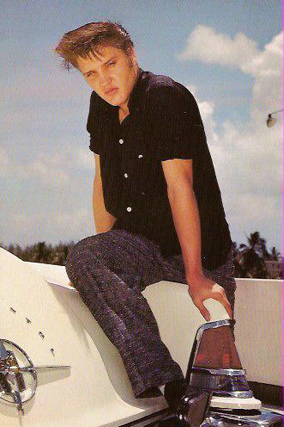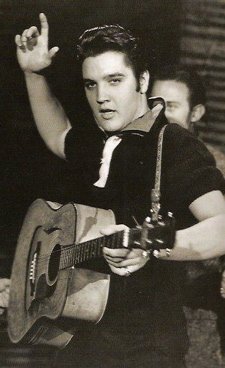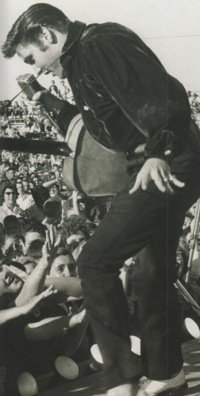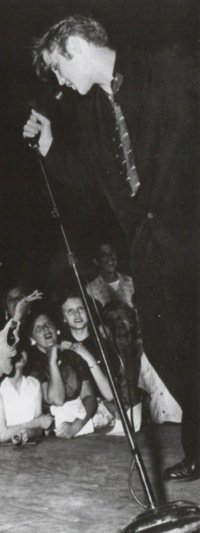Elvis History Blog
Pollster Eugene Gilbert Brought
Reason to the Elvis Debate in the '50s
Back in fifties, everybody had an opinion about rock ’n’ roll and Elvis Presley. Music and entertainment pundits generally condemned both the musical style and its leading proponent. At the other end of the spectrum, teenagers generally embraced rock ’n’ roll and worshiped Elvis as its king. Of course, some critics accepted Elvis and some youths hated him. With so many emotional viewpoints being aired, it was hard to get a handle on Presley’s actual influence on popular culture. At that time, people didn’t have the scientific polling that we depend so much on these days to define societal trends.
There was one man, however, who tried to quantify the concerns of young people in the fifties. Eugene Gilbert, who billed himself as “President of the Gilbert Youth Research Company,” wrote a weekly syndicated newspaper column under the banner, “What Young People Think.” Each week he published and commented on a topic about which his company had surveyed teenagers and their parents across the country.

On at least four occasions during 1956 and 1957, Elvis Presley figured prominently in Gilbert's columns. The first came during the week of August 6, 1956. For that article, Gilbert stated, “Our organization interviewed over 3975 boys and girls and their parents in 41 cities across the nation to find out what young people themselves think about rock ’n’ roll and its influence upon them.”
• California mother feared the “Elvis Presley cult”
Gilbert began his column with the following summary of his findings: “Teen-agers regard Rock ’n' Roll as a revved up version of the Charleston or Lindy-hop; and they see its most noted practitioner, Elvis Presley, as a latter-day disciple of Rudy Vallee or Frank Sinatra. Harried parents, for the most part, scorn this comparison with the music of their salad days.”
Gilbert relied both on statistics and respondents’ comments to make his points. He reported that 73 percent of the teen-agers who considered themselves rock ’n’ rollers said the lyrics of a song were far less important than the “two-beat rhythm.” He also noted that 83 percent of the parents “would prefer to see their children socially occupied in some other direction, but only 29 percent feel so strongly about it that they would like to see rock ’n’ roll banned from their communities.”
Concerning Elvis, Gilbert noted that many mothers and fathers looked “with distaste, not only on his performance, but also on its hypnotic after-effects.” Gilbert cited one San Francisco mother’s foreboding about what she called the “Elvis Presley cult.” He also quoted two teenagers who defended Elvis. “They swooned over Sinatra and drooled over Rudy Vallee,” said a New Jersey girl of parents. “At least Elvis isn’t a milksop. We’ve much better taste—he’s a real hunk of man!” A 16-year-old Texas girl added, “When Elvis sings, I’m on Cloud Nine. He makes me forget everything but the music—and him singing it.”
• Later column pronounced “Presley Fad on the Skids”
Eight months later, however, Gilbert’s survey of teenagers across the nation found the number of Presley’s defenders had dropped considerably. The week of March 17, 1957, Gilbert opened his “What Young People Think” column with the following statement: “Singer Elvis Presley’s phenomenal popularity among the Nation’s teen-agers seems to have taken a nosedive.” He noted that in his nationwide survey the previous October, 35 percent of youngsters listed Elvis as their favorite male singer. But in his most recent poll, that number had dropped down to 21 percent. “That’s still a hefty following—and also a remarkable decline,” Gilbert concluded.
Furthermore, the new survey indicated that 35 percent of teenagers liked Presley less than they had the previous year. “He’s nothing anymore,” Gilbert quoted a 16-year-old girl. “Last year he was news. Today he’s just another wiggler.” Another high school girl added, “Last year I used to think Elvis was the sexiest male alive. But I can see now that he’ll become just another commercial singer, like the rest.”
Gilbert admitted that those were “extreme viewpoints,” and that Presley’s recent movie, Love Me Tender, had apparently resulted in some young fans liking him even more. “Elvis was the very end in that movie. I bet someday he gets an Academy award,” responded one girl. Another acknowledged, “I sat through ‘Love Me Tender’ three times in one afternoon. I was in a happy daze for a week afterward.”
Gilbert offered several other results from his March survey concerning Elvis. First, at 21 percent Presley still topped the “Most Favorite Male Vocalist” category, although Pat Boone, with 13 percent of the vote, was moving up strongly and threatened to depose the King.
• Elvis fans seen as rebels who can’t face adult world
Later in the summer of 1957, Gilbert engaged in what he called “motivational research” to determine “what sort of teen-ager really likes Elvis Presley—idolizes him from the top of his bushy brown hair to the soles of his blue suede shoes?” He started by questioning 100 random teenagers about their school activities, grades, and future plans. From their responses, Gilbert established a pattern for the average teenager. He then used that pattern to come up with a sketch of a typical Presley fan.
The result produced an unfavorable picture of Elvis fans. First, most were not joiners. Only 33% of Presley’s most enthusiastic admirers were members of a club, society, or other school, church, or community group. Pat Boone and Frank Sinatra fans were joiners at a higher rate of 50%. Second, Elvis followers were low achievers in school. The average school grade for Presley fans was “C” compared to “B” or better for the Sinatra and Boone crowd. In fact, 20% of Elvis fans said they didn’t care one way or the other about school grades. Finally, Presley enthusiasts seem unconcerned about the future. Many didn’t bother to respond to the question asking about their future aspirations, and 30% admitted they had “never given it a thought.”
In analyzing these findings, Gilbert’s staff started with the sociological assumption that the typical teenager is faced with a dilemma: “More and more demands are being imposed upon him by the adult world, yet he still clings to his dependent, infantile existence of former years.” Gilbert’s researchers then came to the following conclusion.
“In this nether world between childhood and manhood, Elvis Presley emerges as a symbol of destruction. Presley is unacceptable to the adult world, and, to the unadjusted teen-ager, he seems to mock its cultural taboos. Through an alliance of the spirit with Presley, the teen-ager is able to act out his infantile desires of striving for power through the destruction of adult standards and symbols. He can satisfy his need to belong by uniting with other youngsters of similar aim.”
• "How long will Presley’s popularity last?"
The March survey also asked teenagers how long they thought Presley's popularity would last. Thirty-nine percent of boys and 33 percent of girls predicted that the Elvis “fad” would fade away in less than a year. “Forty-two percent of the girls and 31 percent of the lads gave him from one to two years,” Gilbert added, “and 8.5 and 17 percent, respectively, figured two to four years more, while the rest thought the side-burned rock ’n’ roller wouldn’t fade for another four years yet.” A Duluth, Minnesota, girl explained, “We like him, but you can’t expect a fad to go on forever.”
Despite what Eugene Gilbert’s poll indicated, the Presley “fad” was far from being on the skids. The week after Gilbert’s March column appeared in newspapers, a gold lamé clad Elvis opened his 1957 spring concert tour in Chicago. Huge crowds came out to see him in most of the 18 cities he played that year. His April single release, “All Shook Up,” shot up Billboard’s “Hot 100” and stayed there for 30 weeks. Two more #1 hit records, “Teddy Bear” and “Jailhouse Rock,” followed, both from highly successful Presley movies.
As a result, Presley’s name again showed up in Gilbert’s “What Young People Think” column early in October 1957. The survey question this time was, “Who would you like to be most like when you grow up?” President Eisenhower easily topped the boys’ list with 31 percent of the vote. Elvis Presley, though, came in second with 14 percent. That was more than twice what Vice President Richard Nixon earned in third place. Others finishing well below Elvis were Babe Ruth, John D. Rockefeller, Mickey Mantle, and Albert Schweitzer.
Most of the boys who wanted to be like Elvis coveted his material success. “This Presley lives it up,” one 16-year-old observed. “Cars, gals, money to burn. Any kid would like his share.” A Texas teen zeroed in on the gals. “Girls! Girls! Girls! Elvis has them by the hundred. Man, wouldn’t I dig that! You bet I would!”
• The pollster helped temper the Presley controversy in the fifties
Eugene Gilbert never used the term “scientific” in reference to the polling he did for his “What Young People Think” columns in the fifties. No doubt his methods were primitive compared to those of modern pollsters. For his time, however, Gilbert’s nationwide surveys at least brought some fairness to the emotional Presley controversy. His poll numbers lent some reasonableness to the debate, and he was always careful to make sure both sides had their say.
Of course, in Gilbert’s March 1957 poll, those 39 percent of boys and 33 percent of girls who felt the Presley “craze” would end in less than a year were right. It wasn't, however, because Elvis’ gyrating rock ’n’ roll style lost its allure among young people. Rather, it was Uncle Sam who ended the Presley “fad” in March 1958. — Alan Hanson | © May 2010
Reader Comment: I just read with interest your column about Elvis and Eugene Gilbert Youth research! Gene was my cousin. His real last name was Goldberg. In 1949, he borrowed $2,000 and went to N.Y. with an idea. Within a short time he became a millionaire. He was the first to use computers for youth surveys. He rented a Univac when it was not in use after 5 p.m. and on weekends. He attracted all kinds of national businesses because there was no such thing as a youth market. G.E. came to him to see what color transistor radios should be. Arrow shirts also, and would you believe Phillip Morris wanted to know teen smoking habits? He also took adult surveys for booze companies and political trends. He created the Campus Pack, samples for students from aftershave to no
Go to Elvis History
Go to Home Page

"Through an alliance of the spirit with Presley, the teen-ager is able to act out his infantile desires of striving for power through the destruction of adult standards."







